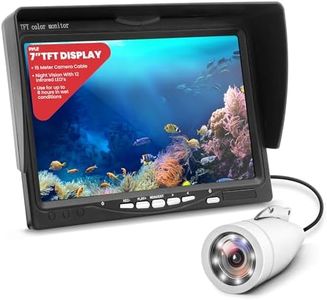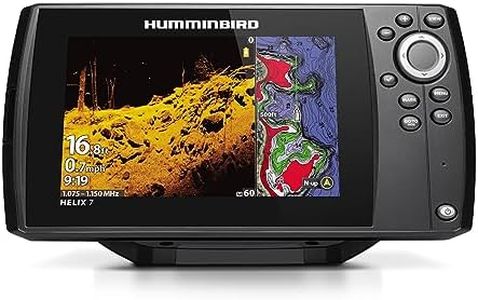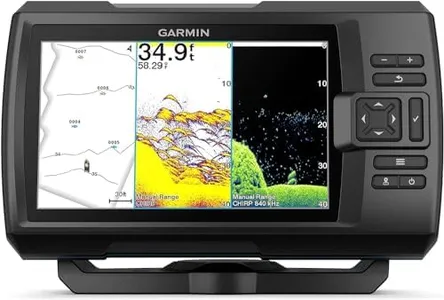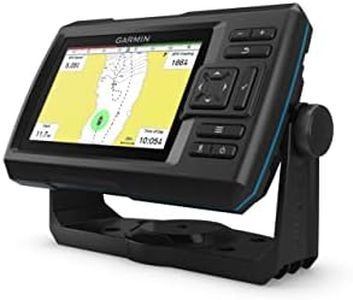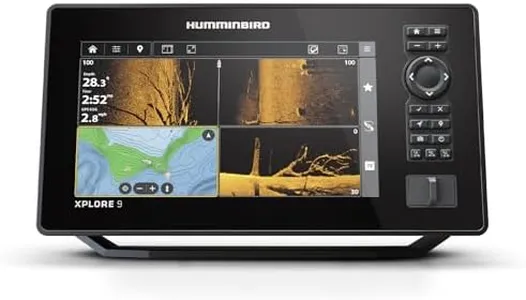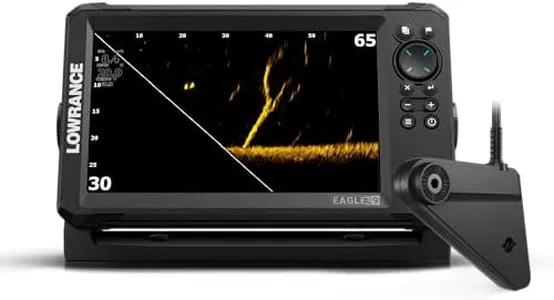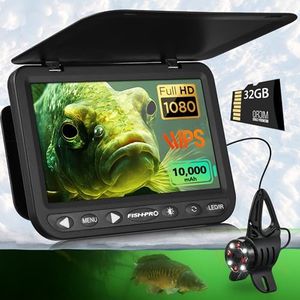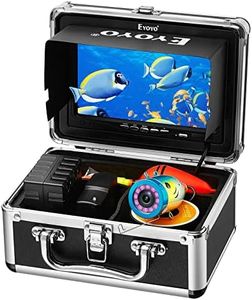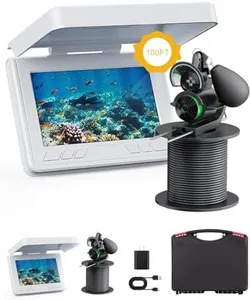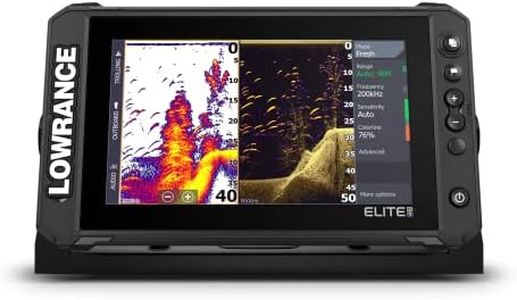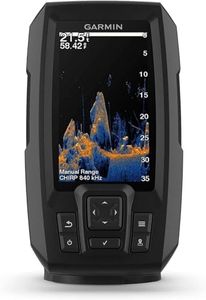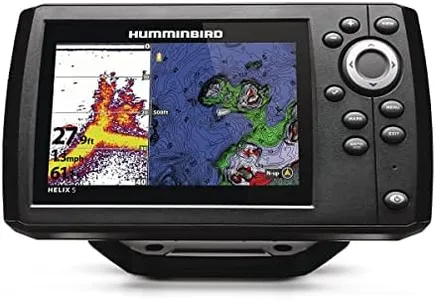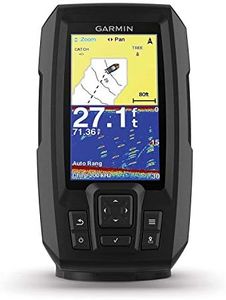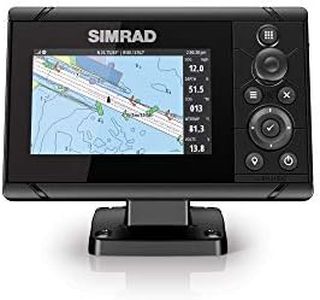10 Best Fish Finder For Pontoon Boat 2025 in the United States
Our technology thoroughly searches through the online shopping world, reviewing hundreds of sites. We then process and analyze this information, updating in real-time to bring you the latest top-rated products. This way, you always get the best and most current options available.

Our Top Picks
Winner
Humminbird 411610-1 HELIX 7 CHIRP MEGA DI GPS G4
Most important from
92 reviews
The Humminbird 411610-1 Helix 7 Chirp MDI GPS G4 Fish Finder is a solid choice for pontoon boat owners who seek reliable and detailed underwater visuals. This device boasts a 7-inch color TFT display, which provides clear and vibrant images, making it easy to view the underwater terrain. Its MEGA Down Imaging feature offers exceptional clarity, revealing details up to 125 feet below, which is significantly more precise than standard down imaging sonar.
The Dual Spectrum CHIRP sonar enhances your fishing experience by providing highly-detailed fish arches and clear views of structures on the bottom, giving you two modes to choose from – Wide for maximum coverage, and Narrow for fine details. The internal GPS and Humminbird Basemap are very useful, as they provide comprehensive coastal and inland waterway charts, covering over 10,000 lakes and coastal areas in the continental U.S. This feature ensures you can navigate confidently, identifying various points of interest and hazards.
Furthermore, the AutoChart Live feature allows you to create real-time maps of your favorite fishing spots, which is great for anglers who like to keep detailed records of their fishing locations. One of the drawbacks is that the device is battery powered, which may require additional planning for extended trips to ensure you have enough power. Another consideration is that while the screen size is decent, some users may prefer a larger display for even easier readability. Additionally, the unit's price point may be on the higher side for some buyers, but it does offer a comprehensive set of features that justify the cost. The Humminbird Helix 7 is a well-rounded fish finder that should satisfy both casual and serious anglers looking to improve their fishing efficiency on a pontoon boat.
Most important from
92 reviews
Garmin Striker Vivid 7cv, U.S. with GT20-TM Transducer - Easy-to-Use 7-inch Color Fishfinder and Sonar Transducer, Vivid Scanning Sonar Color Palettes (010-02552-00)
Most important from
325 reviews
The Garmin Striker Vivid 7cv is a strong contender for those looking for a fish finder tailored to pontoon boating. With a 7-inch color display, it offers vivid scanning sonar color palettes that help users easily differentiate between fish and underwater structures, making it user-friendly for both novice and experienced anglers. The included GT20 transducer supports both traditional CHIRP sonar and CHIRP ClearVü scanning, enhancing your ability to identify fish and their surroundings.
Its high-sensitivity GPS is a key feature, allowing you to mark waypoints, set routes, and monitor your boat's speed—great for navigating and returning to productive fishing spots. Additionally, the built-in Quickdraw Contours mapping lets you create custom maps of your favorite areas, adding to its utility.
Connectivity is another highlight, as it includes Wi-Fi support for the ActiveCaptain app, enabling you to transfer waypoints and receive notifications directly to your smartphone. This feature is particularly useful for staying updated on software changes and accessing a community of users for shared insights.
However, there are a few drawbacks to consider. While the display size is adequate, some users might find that in bright sunlight it can be challenging to see clearly, which may affect usability during sunny days. The reliance on buttons for navigation, while straightforward, can feel outdated compared to models with touchscreens. The device is primarily battery-powered, so keeping an eye on battery life is essential during extended outings.
In terms of affordability, it sits comfortably in the mid-range for fish finders, making it accessible for hobbyists but perhaps not feature-rich enough for hardcore anglers seeking advanced technologies.
Most important from
325 reviews
Garmin Striker Vivid 5cv, Easy-to-Use 5-inch Color Fishfinder and Sonar Transducer, Vivid Scanning Sonar Color Palettes (010-02551-00)
Most important from
216 reviews
The Garmin Striker Vivid 5cv is a solid choice for those seeking an easy-to-use fish finder for their pontoon boat. Its 5-inch color display is vivid and clear, making it easy to distinguish fish and underwater structures. The device supports both CHIRP traditional sonar and CHIRP ClearVü scanning sonar, enhancing its ability to provide detailed and accurate readings.
The included high-sensitivity GPS allows you to mark waypoints, create routes, and monitor your boat’s speed, which is particularly useful for navigation and fishing trips. Additionally, it comes with built-in Quickdraw Contours mapping, enabling you to create custom fishing maps with 1’ contours as you fish, thus improving your fishing experience over time. The package requires a compatible transducer to fully utilize the CHIRP capabilities, and while it includes a GT20-TM transducer, this might be an extra consideration for some users.
The product is relatively lightweight at 3.8 pounds and has a compact design, which makes it suitable for mounting on a pontoon boat's dashboard. The device is battery-powered, ensuring portability. While it has Wi-Fi capabilities for display features, it lacks advanced connectivity options like Bluetooth, which might be a drawback for those looking for more integrated tech solutions. The unit is also button-operated, which might not be as intuitive for users accustomed to touchscreen interfaces. The Garmin Striker Vivid 5cv offers a bright display, solid sonar capabilities, and useful mapping features, making it a great tool for anglers on pontoon boats, despite a few minor limitations.
